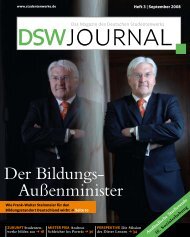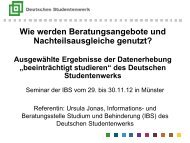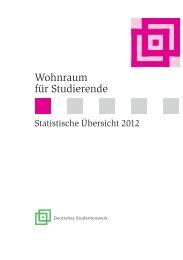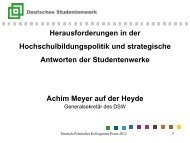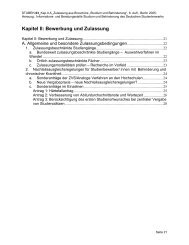the role of student affairs and services in higher education
the role of student affairs and services in higher education
the role of student affairs and services in higher education
Create successful ePaper yourself
Turn your PDF publications into a flip-book with our unique Google optimized e-Paper software.
SECTION IV – RESEARCH, EVALUATION, ASSESSMENT, AND<br />
STRATEGIC PLANNING IN HIGHER EDUCATION<br />
STUDENT AFFAIRS AND SERVICES<br />
Fundamental to any pr<strong>of</strong>ession is <strong>the</strong> capacity <strong>and</strong> will<strong>in</strong>gness to objectively<br />
assess <strong>and</strong> evaluate program <strong>and</strong> service delivery. The <strong>student</strong> <strong>affairs</strong> <strong>and</strong><br />
<strong>services</strong> pr<strong>of</strong>ession is no different. This staff <strong>of</strong> pr<strong>of</strong>essionals provides a most<br />
critical <strong>and</strong> valuable early warn<strong>in</strong>g system to university management on issues<br />
affect<strong>in</strong>g <strong>student</strong>s <strong>and</strong> <strong>the</strong>ir social <strong>and</strong> learn<strong>in</strong>g environments. In <strong>the</strong> forefront <strong>of</strong><br />
assessment <strong>and</strong> evaluation is data collection that allows comparison <strong>and</strong><br />
benchmark<strong>in</strong>g among <strong>services</strong>. Recently, attention <strong>of</strong> <strong>student</strong> <strong>affairs</strong> <strong>and</strong><br />
<strong>services</strong> has turned directly to <strong>the</strong> improvement <strong>of</strong> <strong>student</strong> learn<strong>in</strong>g outcomes<br />
through <strong>education</strong>al programm<strong>in</strong>g that is <strong>in</strong>tended to facilitate <strong>the</strong> learn<strong>in</strong>g goals<br />
<strong>of</strong> <strong>the</strong> <strong>in</strong>stitution. Thus, outcomes assessment also has become a tool for <strong>the</strong>se<br />
staff members. Accord<strong>in</strong>gly, <strong>student</strong> <strong>affairs</strong> <strong>and</strong> <strong>services</strong>, because <strong>of</strong> its central<br />
mission, is one <strong>of</strong> <strong>the</strong> most appropriately positioned entities for <strong>the</strong> collection <strong>of</strong><br />
mean<strong>in</strong>gful <strong>student</strong> data that, once evaluated <strong>and</strong> understood, can be used <strong>in</strong><br />
appropriate research <strong>and</strong> program development.<br />
Some <strong>of</strong> <strong>the</strong> actual assessment techniques that are commonly used <strong>in</strong> <strong>student</strong><br />
<strong>affairs</strong> <strong>and</strong> <strong>services</strong> <strong>in</strong>clude mail <strong>and</strong> on-l<strong>in</strong>e surveys, focus groups, <strong>in</strong>dividual<br />
<strong>in</strong>terviews, writ<strong>in</strong>g samples <strong>in</strong>clud<strong>in</strong>g personal journal<strong>in</strong>g, portfolios, project<br />
development, benchmark<strong>in</strong>g, demography, <strong>and</strong> o<strong>the</strong>r comparative studies, <strong>and</strong><br />
more traditional test<strong>in</strong>g. In order to improve programs <strong>and</strong> <strong>services</strong> <strong>and</strong><br />
determ<strong>in</strong>e if <strong>student</strong>s have learned <strong>the</strong> <strong>in</strong>tended outcomes result<strong>in</strong>g from those<br />
programs <strong>and</strong> <strong>services</strong>, <strong>in</strong>formation <strong>and</strong> data are collected to:<br />
• determ<strong>in</strong>e <strong>the</strong> effectiveness <strong>of</strong> promotional material<br />
• establish dem<strong>and</strong>, need, focus, <strong>and</strong> applicability; gauge <strong>student</strong> satisfaction<br />
• assess quality <strong>of</strong> effort; determ<strong>in</strong>e program success rates<br />
• benchmark current practices aga<strong>in</strong>st <strong>the</strong> best at o<strong>the</strong>r <strong>in</strong>stitutions<br />
• track <strong>the</strong> number <strong>of</strong> <strong>student</strong>s attend<strong>in</strong>g programs; monitor wait<strong>in</strong>g lists<br />
• monitor <strong>the</strong> sources <strong>of</strong> <strong>student</strong> referrals; monitor outside agency referrals<br />
• determ<strong>in</strong>e <strong>student</strong> attrition <strong>and</strong> retention rates; track graduation rates<br />
• receive <strong>student</strong> feedback on key issues <strong>and</strong> ideas, assess unmet needs<br />
• assess campus learn<strong>in</strong>g <strong>and</strong> physical environments; assess learn<strong>in</strong>g outcomes<br />
• track <strong>student</strong> employment rates upon graduation<br />
RESEARCH AND DATA COLLECTION<br />
The <strong>higher</strong> <strong>education</strong> system across <strong>the</strong> globe has <strong>in</strong>creas<strong>in</strong>gly experienced a<br />
transition from an elitist system to a mass or nearly universal system, with <strong>the</strong><br />
result that <strong>the</strong> traditional view <strong>of</strong> <strong>the</strong> <strong>student</strong> has been chang<strong>in</strong>g. Widen<strong>in</strong>g<br />
participation strategies have seen a diversification <strong>of</strong> <strong>the</strong> <strong>student</strong> body not only <strong>in</strong><br />
21




